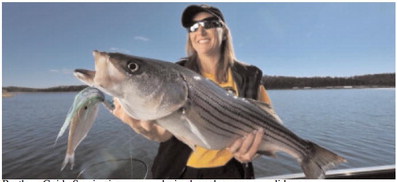Fishing Lake Norfork

Anglers having luck in one of state’s mos popular fishing holes
AGFC Communications f
• Norfork Lake — Lou Gabric at Hummingbird Hideaway Resort said Norfork Lake fishing has been good over the last several weeks and should remain the same if not better for the foreseeable future. “It is really hard to say what the best bite is at this time because all species seem to be biting very good most days,” he said. “As is normal for this time of year the best bite is typically at sunrise and then again at sunset. This is not to say there will not be a good bite during the middle part of the day. I guess you just need to spend the whole day on the lake fishing.”
Tom Reynolds of STR Outfitters said, “I was wrong last week when I said this past week would see lots of fish activity on Norfork Lake. The warm weather promised never materialized. Instead we had rain almost every day with some heavy downpours. There was some shad spawning in Big Creek last Wednesday afternoon. I was crappie fishing with no luck because the crappie are still off the banks. My son was catching shad and found threadfin spawning in a debris slick on a bluff wall.
I assumed that was happening all over the lake until Sean told me the main lake was only 60 degrees. Sean had several good days fishing the main lake points near the dam, but the weather kept changing the pattern. One day stripers were active on the main lake and then the next day they were way up the creek. Nothing is consistent right now. Once we see consistent warm nights and south winds, the whole lake will see topwater bites and lots of feeding activity.”
The stripers should begin to feed on the main lake points and near mid-creek bluffs and on the flats up the creeks. Some good places to try this time of year are: Cranfield Island, Crystal Cove, Koso Point, Dam Cove, Big and Brush creeks, Woods Point, Diamond Bay, Thumb Point and School Bus Point.
• Norfork Tailwater — John Berry of Berry Brothers Guide Service in Cotter (870-435-2169) said that last week, leading up to last Friday, Norfork Lake fell 0.1 foot to rest at 14.2 feet above seasonal power pool of 555.9 feet msl and 9.9 feet below the top of flood pool. The Norfork tailwater had heavy flows and no wadable water. The Norfork is fishing better. Navigate this stream with caution as things have changed a bit during the recent flooding. There has been major gravel recruitment at the bottom of Mill Pond and the dock hole.
The most productive flies have been small midge patterns (sizes 18, 20, 22) like ruby midges, root beer midges, zebra midges (black or red with silver wire and silver bead) and soft hackles (sizes 14, 16) like the Green Butt. Egg patterns have also been productive. Double-fly nymph rigs have been very effective. Try a small ruby midge (sizes 18) suspended 18 inches below a red fox squirrel and copper. The fishing is better in the morning.
Dry Run Creek is fishing very well. With the coronavirus pandemic there has been little pressure. The hot flies have been sowbugs (size 14), Y2Ks (size 12), various colored San Juan worms (worm brown, red, hot fluorescent pink and cerise size 10) and mop flies.
Remember that the White and Norfork Rivers and Dry Run Creek are infected with didymo, an invasive alga. Thoroughly clean and dry your waders (especially the felt soles on wading boots) before using them in any other water. Many manufacturers are now making rubber soles that are easier to clean and are not as likely to harbor didymo.
• Buffalo National River/Crooked Creek — NOTE: The U.S. Fish and Wildlife Service, at the urging of Gov. Asa Hutchinson, has closed access to the Buffalo National River for the time being due to the coronavirus pandemic.
John Berry of Berry Brothers Guide Service in Cotter (870-435-2169) said the Buffalo National River and Crooked Creek are high and off-color. John s favorite fly here is a Clouser minnow. Carefully check the water level before entering Crooked Creek or the Buffalo River.
There are no dams on these streams. They both have large drainages and are prone to flooding during and following any rain event. The water can rise very quickly.



Share